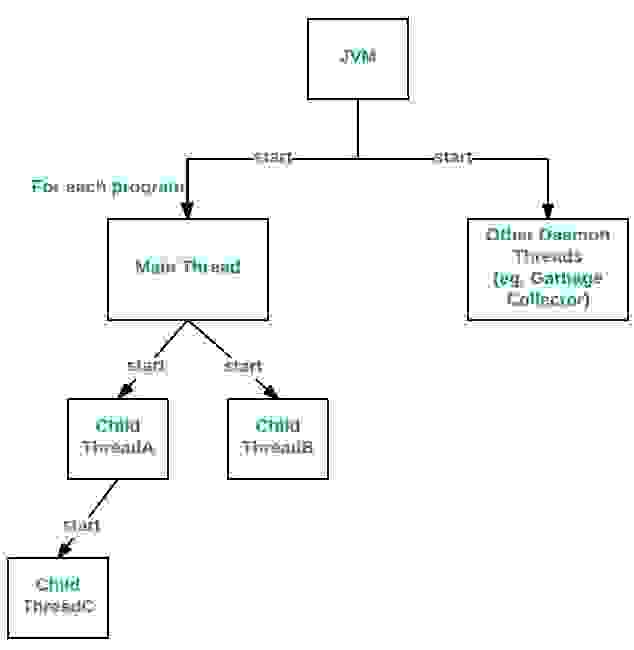Java为多线程编程提供了内置支持。多线程程序包含两个或多个可以同时运行的部分。这样一个程序的每一部分都被称为线程,每个线程定义一个单独的执行路径。 当Java程序启动时,一个线程立即开始运行。这通常被称为 主要的 线程,因为它是程序开始时执行的线程。
与主线程相关的某些属性如下:
- 它是其他“子”线程将从中派生的线程。
- 通常,它必须是最后一个完成执行的线程,因为它执行各种关闭操作
流程图如下:

如何控制主线程
主线程是在程序启动时自动创建的。为了控制它,我们必须获得对它的引用。这可以通过调用方法来实现 当前线程() 这在线程类中存在。此方法返回对调用它的线程的引用。主线程的默认优先级为5,对于所有剩余的用户线程,优先级将从父线程继承到子线程。
实例
JAVA
// Java program to control the Main Thread // Importing required classes import java.io.*; import java.util.*; // Class 1 // Main class extending thread class public class Test extends Thread { // Main driver method public static void main(String[] args) { // Getting reference to Main thread Thread t = Thread.currentThread(); // Getting name of Main thread System.out.println( "Current thread: " + t.getName()); // Changing the name of Main thread t.setName( "Geeks" ); System.out.println( "After name change: " + t.getName()); // Getting priority of Main thread System.out.println( "Main thread priority: " + t.getPriority()); // Setting priority of Main thread to MAX(10) t.setPriority(MAX_PRIORITY); // Print and display the main thread priority System.out.println( "Main thread new priority: " + t.getPriority()); for ( int i = 0 ; i < 5 ; i++) { System.out.println( "Main thread" ); } // Main thread creating a child thread Thread ct = new Thread() { // run() method of a thread public void run() { for ( int i = 0 ; i < 5 ; i++) { System.out.println( "Child thread" ); } } }; // Getting priority of child thread // which will be inherited from Main thread // as it is created by Main thread System.out.println( "Child thread priority: " + ct.getPriority()); // Setting priority of Main thread to MIN(1) ct.setPriority(MIN_PRIORITY); System.out.println( "Child thread new priority: " + ct.getPriority()); // Starting child thread ct.start(); } } // Class 2 // Helper class extending Thread class // Child Thread class class ChildThread extends Thread { @Override public void run() { for ( int i = 0 ; i < 5 ; i++) { // Print statement whenever child thread is // called System.out.println( "Child thread" ); } } } |
Current thread: mainAfter name change: GeeksMain thread priority: 5Main thread new priority: 10Main threadMain threadMain threadMain threadMain threadChild thread priority: 10Child thread new priority: 1Child threadChild threadChild threadChild threadChild thread
现在,让我们讨论一下Java中main()方法和主线程之间的关系。 对于每个程序,一个主线程由 JVM (Java虚拟机)。“Main”线程首先验证Main()方法的存在,然后初始化该类。注意,在JDK 6中,main()方法在独立java应用程序中是必需的。
使用主线程的死锁(仅单线程)
我们可以只使用主线程来创建死锁,也就是说,只使用一个线程。
实例
JAVA
// Java program to demonstrate deadlock // using Main thread // Main class public class GFG { // Main driver method public static void main(String[] args) { // Try block to check for exceptions try { // Print statement System.out.println( "Entering into Deadlock" ); // Joining the current thread Thread.currentThread().join(); // This statement will never execute System.out.println( "This statement will never execute" ); } // Catch block to handle the exceptions catch (InterruptedException e) { // Display the exception along with line number // using printStackTrace() method e.printStackTrace(); } } } |
输出:
![图片[2]-Java中的主线程-yiteyi-C++库](https://www.yiteyi.com/wp-content/uploads/geeks/20210729/geeks_Screenshot20210729at44645AM.png)
输出说明: 语句“Thread.currentThread().join()”将告诉主线程等待该线程(即等待自身)死亡。因此,主线程等待自己消亡,这只不过是一个死锁。
相关文章: Java中的守护进程线程 . 本文由 高拉夫·米格拉尼 .如果你喜欢GeekSforgek,并想贡献自己的力量,你也可以使用 写极客。组织 或者把你的文章寄去评论-team@geeksforgeeks.org.看到你的文章出现在Geeksforgeks主页上,并帮助其他极客。 如果您发现任何不正确的地方,或者您想分享有关上述主题的更多信息,请写下评论。


![关于”PostgreSQL错误:关系[表]不存在“问题的原因和解决方案-yiteyi-C++库](https://www.yiteyi.com/wp-content/themes/zibll/img/thumbnail.svg)






